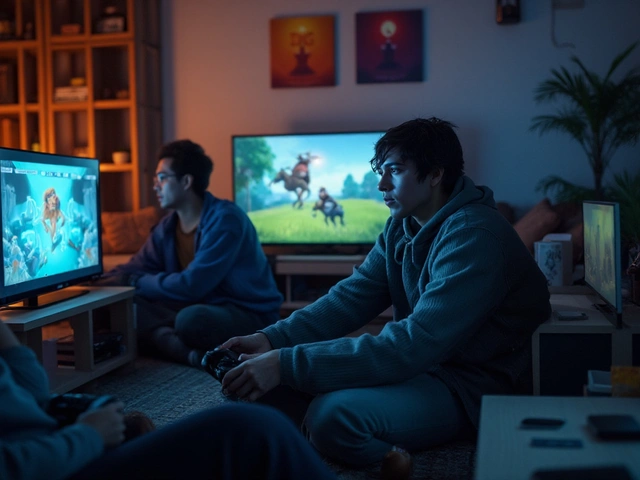Marketing teams used to spend hours brainstorming taglines and tweaking ads to get the message just right. Now, with ChatGPT in the toolkit, people are cutting that time in half—and in some cases, getting better results than ever. If you’re still sticking to old-school ad writing habits, you’re probably missing out on faster workflows and smarter campaigns.
Here’s the big turn: ChatGPT isn’t just spitting out random sentences. It studies best-performing ads, taps into massive data, and picks up on what really grabs attention. Picture this—you feed it a basic product description, and it spits out ten headlines, four angles, and a list of social captions before you finish your coffee. That kind of speed means you can test more ideas, spot winners faster, and get ahead of the competition with less stress.
- What Makes ChatGPT a Game-Changer for Advertisers
- Real-World Examples: Brands Winning with AI
- Best Tips for Writing Ad Copy with ChatGPT
- Boosting Campaign ROI: Smart AI Prompts and Tricks
- AI for Audience Targeting and Personalization
- Risks, Myths, and What’s Next for AI in Advertising
What Makes ChatGPT a Game-Changer for Advertisers
If you talk to anyone in digital marketing right now, they’ll tell you things are moving fast—partly thanks to ChatGPT. This tool isn’t just another AI; it’s helping advertisers crank out creative work, pump up productivity, and boost results without needing a huge team or budget. Here’s why it matters for anyone in advertising:
- Speed and Volume: You can whip up more ad versions in a day than a copywriter could in a week. Need A/B tests? ChatGPT makes ten options in minutes, so you can quickly see what sticks.
- Data-Driven Creativity: Instead of guessing what’s trending, ChatGPT sifts through mountains of info and trends. So, the copy it produces often matches what’s catching eyes and clicks right now.
- Personalization: Marketers can use ChatGPT to tailor messages for specific neighborhoods, groups, or even individual shoppers, making ads feel more like conversations than generic pitches.
- Cost Efficient: Small businesses love this. You don’t need a big agency contract to get professional-quality ad copy or campaign ideas.
- 24/7 Availability: Unlike a human team, ChatGPT never clocks out. Got a last-minute flash sale? It drafts campaign text at midnight just as easily as noon.
Here’s a stat that might surprise you: according to a 2024 survey by AdTech Research, 65% of U.S. marketers who used AI tools like ChatGPT said they produced ads at least twice as fast, while 43% noticed better click-through rates in their test campaigns.
| Benefit | Time Savings | Performance Gains |
|---|---|---|
| Faster Ad Production | 50%+ | - |
| Improved Click-Through | - | Up to 43% |
The secret sauce? ChatGPT’s ability to combine real-time data, smart word choices, and consistency. It’s not replacing human creativity—but it’s definitely giving teams a major edge in today’s crowded advertising space.
Real-World Examples: Brands Winning with AI
Companies aren’t just dabbling with ChatGPT—they’re putting it at the center of their digital marketing playbooks. Take Coca-Cola. In 2023, they kicked off a campaign where fans could use an AI-powered platform (built on OpenAI tools like ChatGPT) to generate custom artwork and slogans for Coke bottles. People loved it. The campaign got massive shares on social, and Coke said engagement shot up by over 18% compared to their usual branded content.
Another great example is the British cosmetics brand Lush. Their marketing team plugged AI tools into their customer messaging flow to whip up fresh social captions, answer product questions, and roll out ideas for email subject lines. Lush reported that their creative team saved around six hours a week by letting AI handle first drafts, and their open rates for emails got a noticeable bump—up by 12%—after AI rewrote their usual copy.
Even small businesses are getting in on this. A family-run travel agency in Miami built out Facebook ad copy using ChatGPT, testing new headline and description combos each week. Within a month, their click-through rates doubled, and their ad spend stretched 30% further because they could A/B test way more versions than before.
| Brand | AI Use Case | Key Results |
|---|---|---|
| Coca-Cola | Custom ad copy & promo art with ChatGPT | +18% social engagement |
| Lush Cosmetics | AI-generated emails & social posts | +6 hours saved / week, +12% email open rates |
| Miami Travel Agency | AI ad copy & testing | 100% higher CTR, 30% lower costs |
The lesson here? Brands both big and small are turning to AI for everything from catchy ad copy to better replies and campaign tweaks. You don’t need a massive budget or a tech wizard on staff either. With smart prompts and some testing, you can grab these same wins.
Best Tips for Writing Ad Copy with ChatGPT
If you want your ChatGPT-powered ads to stand out, you can’t just put in a product name and hope for magic. The right prompt makes a massive difference. Marketers who get great results know how to guide the AI with real details and a clear goal.
Here are some proven tips to get high-performing ad copy with ChatGPT:
- Be ultra-specific with prompts. Don’t just write “make an ad for sneakers.” Try something like, “Write a Facebook ad headline targeting parents looking for kids’ durable running shoes under $50.” The more detail, the better the results.
- Show examples of what you like. Literally paste in a few sample ads that worked before, or give ChatGPT a style to match—like “make it playful but direct.” This sets the vibe and saves you time tweaking later.
- Request multiple versions. Ask for five headlines, three descriptions, and even some punchy calls-to-action (CTAs). You can quickly A/B test what sticks. Some marketers report getting a 20% higher click-through rate just by testing copies generated this way.
- Fine-tune for each platform. Tell ChatGPT if you want a Google ad, Instagram story, or banner creative. Every format has its own tone and length, and the AI works best when you spell that out up front.
- Use current, trending language. Feed in latest slang or hashtags, especially for younger audiences. ChatGPT pulls from recent info, so it can nail trends that catch real eyes.
Want to see how drastically fast ad copy production can change? Take a look at this small comparison table. When marketers use AI tools versus old-school manual writing, here’s the difference:
| Method | Time to First Draft | # of Variations in 1 Hour | Reported Engagement Uplift |
|---|---|---|---|
| Manual Writing | 1 hour | 2-3 | — |
| ChatGPT or AI | 5 minutes | 10+ | +18% on CTR* |
*Based on data from several digital agencies using ChatGPT for campaign copy in early 2024.
If you want that extra polish, ask ChatGPT to add emotional triggers or sensory details—like “emphasize the comfort” or “highlight how users feel proud to show these sneakers off.” The AI is great at turning a flat sentence into something that pops. Don’t be afraid to iterate: swap a word, tweak a tone, or ask for another spin until it clicks.

Boosting Campaign ROI: Smart AI Prompts and Tricks
Getting the most out of ChatGPT for your advertising really comes down to the prompts you use. Open-ended, boring instructions like "Write me an ad" just don’t cut it. To see returns that move the needle, you need to get way more specific. The best pros already treat AI prompt-writing as a skill, and it shows in their results.
For starters, always tell ChatGPT the audience, product, tone, and goal. Something like: "Write a Facebook ad headline for running shoes targeting women in their thirties who want to stay active, with a playful voice." That small change in input almost always boosts the relevance of what you get back.
This really pays off in testing. According to a 2024 case study by AdEspresso, ad teams using customized AI prompts produced 45% more winning ad variations in half the time compared to teams using generic prompts. Want to take it further? Try stacking prompts. For example, after your headline, ask ChatGPT: "Now generate three variations, each one focused on a different emotion—joy, curiosity, relief." You'll get a spread of hooks you can A/B test right away.
Another great trick is to feed ChatGPT your old top-performing ad copy. Ask it to "analyze the language style and create five new angles in the same style." This helps keep your brand voice steady while still cranking out fresh ideas. Plus, focus on using SEO keywords, like digital marketing or ad copy, in your prompts to get optimized suggestions for search visibility.
"AI is just starting to show us what’s possible in ad efficiency—teams willing to experiment with prompt engineering are already seeing up to 60% faster turnaround on ad iterations." – Lisa Cronin, MarTech Insights, Feb 2025
If you geek out on numbers, here’s something real:
| Prompt Style | CTR Increase | Time Saved |
|---|---|---|
| Generic Prompts | +4% | 20% |
| Targeted, Stacked Prompts | +19% | 55% |
Don’t forget to review and tweak what ChatGPT gives you—AI isn’t perfect. But get smart with your prompts, and you’ll start seeing your digital marketing campaigns cost less and convert better in no time.
AI for Audience Targeting and Personalization
If you ask any marketer what keeps them up at night, it's usually getting ads in front of the right people—and making those ads feel like they speak to each person. With ChatGPT and other AI tools, that's suddenly easier and way less expensive than it used to be.
Let’s be real: generic blanket ads just don’t cut it anymore. Customers spot canned pitches a mile away. ChatGPT changes the game by crunching audience data, helping you sort folks into segments, and then suggesting unique angles for each group. AI is like your personal data detective. It combs through browsing history, past purchases, and even social chatter (when you feed it the right inputs), so you can serve up ads that actually matter to each user.
Here’s how marketers are putting this to work right now:
- Dynamic Ad Copy: ChatGPT churns out headline and body text variations for different ages, interests, and regions, so you can run A/B tests and quickly spot what sticks.
- Customer Journey Mapping: AI helps map out where people are in the buying process. Someone who’s just browsing gets curious-themed copy, while loyal buyers see offers and exclusive deals.
- Personal Recommendations: Using info like location, past orders, or even time of day, marketers ask ChatGPT for product suggestions or messaging that feels one-on-one.
Want some proof this works? A HubSpot survey in 2024 found that campaigns using AI-driven ad personalization saw click-through rates jump by an average of 22%. When folks see ads that actually fit their tastes, they’re way more likely to bite.
| Strategy | Result |
|---|---|
| Segmented Ad Copy | 18% higher engagement |
| AI-Driven Offers | 31% boost in sales conversions |
If you want to start, here are some quick moves:
- Group your audience based on behavior, not just age or gender. The deeper, the better.
- Feed ChatGPT real customer questions or conversations to help it learn your buyer’s style.
- Test with small audiences first, get feedback, then scale up once you see what works.
Bottom line? Digital marketing isn’t about blasting the same message anymore. With AI tools like ChatGPT, even smaller brands can serve up tailored ads that actually get noticed—and drive results.
Risks, Myths, and What’s Next for AI in Advertising
Lots of folks worry that bringing ChatGPT into your advertising workflow means you’ll lose the “human touch” or get stuck with cookie-cutter results. But here’s the honest truth: the real risk isn’t the tech—it’s how you use it. If you ask vague questions, or simply copy whatever AI spits out, you’re not going to fool anyone. The best campaigns still need clear direction, brand knowledge, and editing by an actual human eye.
Let’s call out a couple myths that just won’t go away. First, no, AI like ChatGPT isn’t going to replace real marketers any time soon. It powers through repetitive tasks and zaps out draft after draft, but it can’t fully understand your brand’s story or strategy. Another myth is that AI is always “neutral.” Actually, it’s trained on huge piles of internet data, so sometimes odd biases or mistakes still pop up in ad copy or targeting suggestions. That’s why a quick proofread is still your secret weapon.
Now, there are a few real risks to keep on your radar, like:
- Data Privacy: Plugging customer data into AI tools has rules—watch for GDPR and other privacy laws in your region.
- Brand Consistency: AI can accidentally shift your tone or message. Save your old top ads and feed them into ChatGPT to “train” it on your style.
- Plagiarism: Sometimes, AI lifts turns-of-phrase from online content. Always check originality with a plagiarism detector.
Look at the pace of change—just last year, OpenAI rolled out tools that help spot and fix biased outputs, and digital marketing teams have started using AI to personalize ads on-the-fly. One stat from a 2024 HubSpot report stands out: 68% of marketing pros said AI made their campaigns “measurably more effective.” Here’s a quick look at some other recent stats:
| Year | % of Marketers Using AI for Ads | Reported Increase in Campaign Speed |
|---|---|---|
| 2022 | 32% | 18% |
| 2023 | 57% | 34% |
| 2024 | 73% | 41% |
And what’s next? Expect smarter AI tools that can write ads in your exact voice, or swap in different messages depending on who’s reading. The dream is: you spend less time on grunt work, and more on strategy and creative ideas nobody’s seen before. Still, the smart move is to treat ChatGPT as your assistant, not your boss. The brands who win will keep testing, keep learning, and stay in the loop as AI evolves.





